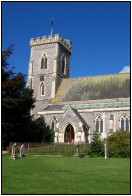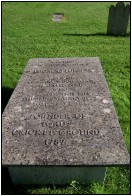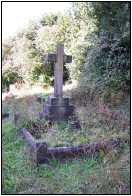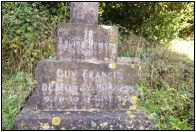| |
 
SECRETS OF A
COUNTRY CHURCHYARD
 |
|
A Hampshire
village made the national headlines
recently when a local resident took his
conviction for speeding to the European
Court of Human Rights. Yet West Meon is
in many ways a typical quiet village, and
is luckier than most as it retains its
school, its shops, including an award
winning butcher, and two pubs. There is
also a pottery which makes handmade
architectural and garden terracotta,
using traditional techniques.
The village is set in glorious
countryside at the head of the Meon
Valley, close to the prehistoric
earthwork of Old Winchester Hill, now a
National Nature reserve.One thing missing
is a mediaeval church, a familiar feature
of almost every other village. St. John
the Evangelist, standing imposingly above
the village, is an early work of no less
an architect than Sir George Gilbert
Scott, dating from 1843-46 and built at
the expense of the then Rector,
Archdeacon Bayley. |
Scott, born in 1811, became
an admirer of Pugin, and went on to represent the
pinnacle of High Victorian Gothic architecture.
He was responsible for the restoration of Ely
Cathedral and Westminster Abbey, and among his
most famous buildings in London we find the
Albert Memorial, St. Pancras Hotel and the
Foreign Office in Whitehall.
In the churchyard
lie the remains of two strongly
contrasted Englishmen. Prominent in the
neatly kept part to the south of the
church stands the imposing tomb slab of
Thomas Lord, founder of Lords Cricket
Ground. The slab was inscribed and placed
on the tomb by the MCC in 1951.
Lord was born in Thirsk, in Yorkshire,
but learnt his cricket at Diss, in
Norfolk, where he went to school. Moving
to London, he went into the wine trade
and found patronage from the nobility,
which enabled him to build a cricket
ground in Dorset Square. The Lord’s
we know today in St. John’s Wood,
headquarters of the Marylebone Cricket
Club, was in fact his third ground. He
retired to West Meon and died there in
1932. Both the Bi-centenary of his birth
and the 250th anniversary were celebrated
by matches at Lord’s involving the
West Meon village team. One of the
village pubs is named in his memory. |
|
 |
In stark contrast, hidden
away, neglected and overgrown behind the tower on
the north side of the church, are buried the
ashes of Guy Burgess, a leading member of the
infamous “Cambridge ring” of Soviet
spies that operated in Britain between the 1930s
and the early 1950s - Burgess, Kim Philby, Donald
Maclean and Anthony Blunt.
His father was a naval officer and he grew up in
the village, before going up to Cambridge in
1921. During the war he worked for the Secret
service, and was later posted to Washington.
 |
|
It was just before
Maclean was due to be interrogated as a
suspected Soviet agent that the KGB
ordered Burgess to return to London to
arrange his escape, and accompany him to
Moscow, where he remained, isolated and
strangely homesick, for the rest of his
life.
| When he
died in 1963, his mother
requested that his ashes be
returned to Britain for burial.
The earthenware pot, decorated
with Russian script, was placed
in the family grave at West Meon.
The service was held late at
night to avoid publicity, and the
words “In loving memory of
Guy Francis De Moncy Burgess,
died 30 August 1963”
inscribed on the side of the
cross. They are still visible
today, yet all but forgotten. |
|
 |
|
Tom Muckley, November 2006
This article was originally
published by the
Petersfield Post
tommuckley.co.uk
|
|





